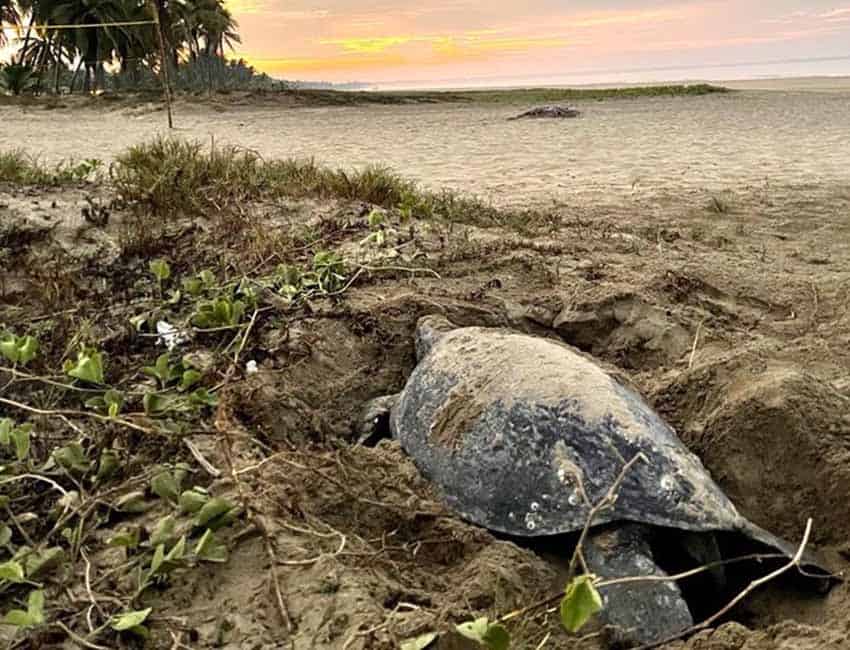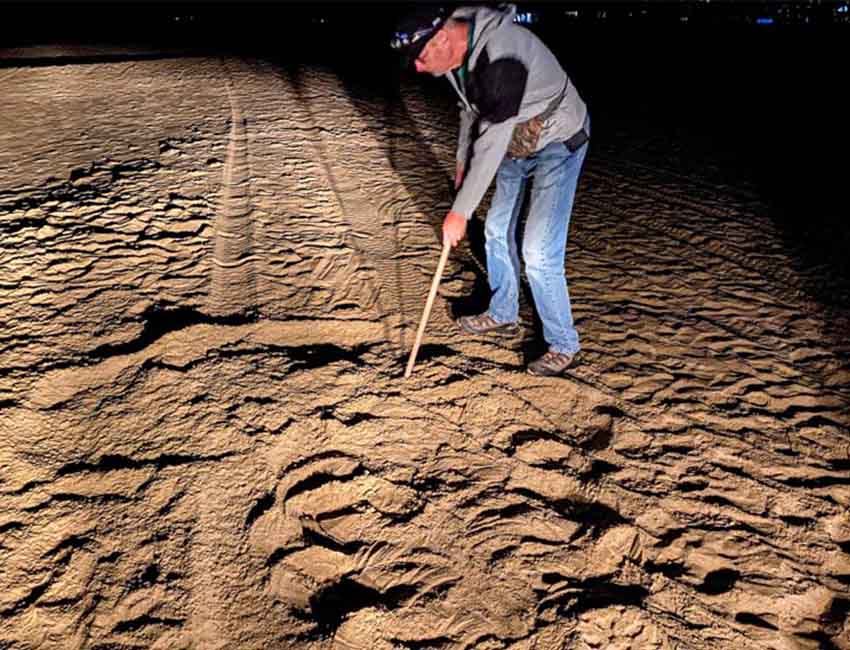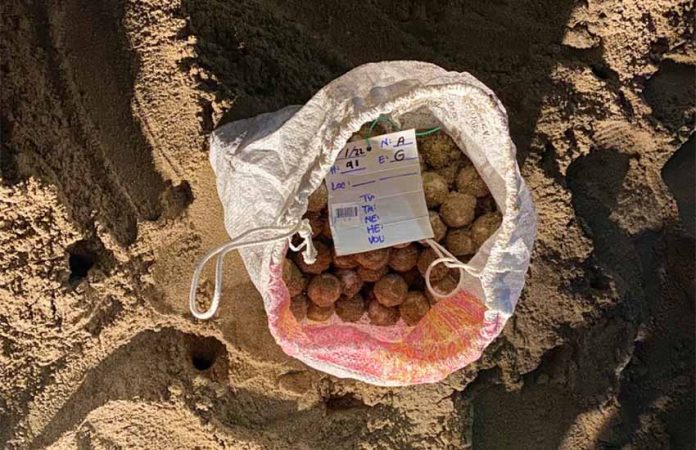Campamento Tortuguero Ayotlcalli (Ayotlcalli Turtle Encampment) is a nonprofit sea turtle sanctuary located just outside of Zihuatanejo on Playa Blanca and founded by Gene and Darius Marin-Smith in 2011. Over the years, it has grown to be one of the most important conservation organizations in the area, with programs aimed at creating awareness about preserving the three types of local turtles they seek to help: the olive ridley; the black turtle, or prieta; and the largest marine turtle in the world, the leatherback.
One of the ways Campamento Tortuguero Ayotlcalli educates the public is by offering locals and tourists the opportunity to ride along on a “turtle patrol.”
Intrigued by the idea and with little knowledge other than I would be expected to ride on an ATV from 11 p.m. to 4 a.m., I decided this was something I needed to experience.
David Hollingsworth, a longtime volunteer with the sanctuary, would be my guide for the evening. Turns out that David knows a lot about turtles, and he filled me in on the ride to the sanctuary.
The first thing I learned was that January was not the typical high season for turtles to nest, but August to November. He warned me that we might not see any action at all tonight, nor find any nests.

The second thing I learned was that should we come upon poachers robbing nests or stealing turtles, we were not to interfere. I must confess that although I could see the wisdom of this, I was secretly disappointed — a part of me had visions of swooping in and scaring away the bad guys.
Thirdly, Hollingsworth gave me a quick lesson on how they record and track the turtles. In addition to writing down the information by hand, they have an app, which gives the organization the very latest in technology.
The app records the date and time, GPS coordinates, the name of the beach where the nests are found and the species of turtle. There are a host of other details as well, such as how many eggs are found and whether the sanctuary has already tagged the turtle in question. It will even tell you if this particular turtle has been on this beach before. The last thing he told me was that, even with our intervention, only one in 1,000 turtles would make it to the Gulf Stream.
By the time we arrived at the sanctuary, I was already impressed by how turnkey and scientific the entire system was.
The first thing we did was check our supplies box containing contain tags, pliers, rubber gloves – because you are never to touch eggs or turtles with your bare hands. There were also poles for prodding the ground looking for eggs, measuring tape, bags to carry the eggs and a cooler to keep safe the ones we found. Then we gassed the ATVs.
I would ride with David, and the second would be driven by Fernando a local and valuable volunteer with the organization, and with founder Marin-Smith who had both arrived just as we finished checking the gear.
Along with Marin-Smith, we checked the egg “corral,” for any turtles that had hatched in the last few hours. We found an olive ridley turtle and recorded the info before releasing him into the ocean.
I was surprised to learn that the corral was checked every few hours, 24 hours a day, seven days a week, a huge manpower commitment and another reason why volunteers are so important to the organization.
Turtles are released within hours of hatching at this sanctuary, which surprised me since I remember that some resorts with turtle programs would keep them in buckets for days before releasing them.
Marin-Smith explained, “Turtles eat their meals from the yolk of their eggs. And they do not eat again until they swim a very long way to the Gulf Stream. All their energy goes into that swim. If they are left too long in captivity, they are using up vital energy needed for the trip. Many will simply run out of energy and not make it to their destination.”
I also learned that they needed to be released at the same stretch of beach on which they were hatched so that their memory would be imprinted in the sand and that they would know where to return when it was time to lay their eggs
By this time, it was 11:15 p.m. and time to head out.

Almost immediately, Marin-Smith and Fernando spotted the signs of a nest. Even when we stopped and they pointed it out to me, it was difficult for me to differentiate the tracks of endless ATVs from the sweeping tracks that a turtles flipper makes in the sand.
But after some poking and prodding with a stick to test the site, we found a nest. I was invited to help dig with a gloved hand the 45 centimeters or so it takes to find the eggs and it was as much fun as an Easter egg hunt. In all, we dug out 91 olive ridley turtle eggs.
This nest was adopted by someone, and so the information recorded was different. We also took photos of the dig, which they would send to the “parents” to update them via email on the progress of their turtles. After handwriting the information and placing it into the bag with the eggs for reference, we were off.
We hoped to cross over to the lagoon, which had been impassable the night before because of tides but tonight, we were in luck.
Once again, thanks to my guides’ eagle eyes, we found tracks to the right. About 10 yards, in we stopped the vehicles and turned off the lights. “We think there is a turtle up ahead,” Marin-Smith told me as we followed the tracks on foot.
They could identify the species, a Prieta — otherwise known as a black turtle — by its prints. In a short while, but quite a distance from the surf, we found her busy digging or covering — it was hard to tell at first. Her powerful flippers flung the sand around.
She was untagged, so Fernando straddled her back carefully and tagged each flipper. He also measured her, not an easy task as she moved out of the nest.
I asked whether she had already laid her eggs or if we had disturbed her and if so, what would happen. Marin-Smith explained that if we had disturbed her during the laying process, she would do any number of things: either move away and try to lay somewhere else or else return to the sea and come back another time.
Our turtle chose to move away back toward from where had come. We let her go. It was time now to check the nest. Our new mother had laid 52 eggs.
The next step was to follow the turtle and see if she had made it to the ocean. Once again, Fernando’s extraordinary eyes picked up the right track, and we found our turtle still quite a distance from where she needed to be. The lights of the neighborhood were distracting her. Instead of heading out, she was moving inland. At this slow “turtle’s pace,” it could be hours before she reached the water, and her energy was waning fast.
Luckily, David and Fernando could lift her — she weighed about 100 pounds — and walk a few yards at a time. But it was plain to see that she was attracted by the lights, and she kept turning away from the ocean.
I remarked that since the turtle kept moving towards the light offshore why couldn’t we shine our flashlights in the direction of where we wanted her to go. Surprisingly, my naive suggestion worked. Finally, after a considerable time, we watched her enter the ocean. If we had not come upon her when we did, it might have been hours before she found her way, and by that time, she would have been exhausted and dangerously dry.

“We have tried to get residents and businesses along this stretch of beach to dim their lights by using softer wattage, but so far, everyone is reluctant to do so — mainly because of security reasons. But it would make it so much easier for the turtles and us if they did.”
After recording all the info and storing the eggs in the cooler, we backtracked and dropped the eggs at the sanctuary before continuing towards Barra de Potosi, a small fishing village. A short while later, we found another nest, this time an olive ridley, and dug up another 84 eggs. I was thrilled that we had managed to not only find three nests in one night but that I had witnessed a turtle’s tagging and her return to the ocean. It was 2:30 a.m.
Once back at the sanctuary, we dug three holes, one for each nest we had found. While Marin-Smith used her phone app to record the information, Hollingsworth and Fernando buried the eggs.
A quick check in the corral turned up three more hatched turtles, which were promptly released. We were now free to go home — two sleeping volunteers in the bunkhouse would take over in a few hours.
Weary but mostly exhilarated, we headed back to Ixtapa-Zihuatanejo for a good night’s rest — or what was left of it.
I highly recommend this experience, which costs a minimum donation of US $25 per person and you can book by contacting the shelter. You can also donate to the sanctuary or adopt a turtle in your or someone else’s name. You can join in on a turtle release. Donation required.
To learn more, visit Campamento Tortuguero Ayotlcalli’s website or Facebook page, contact them on Twitter at @Ayotlcalli, or email them. They also can be reached by phone in Zihuatanejo at 755 121 1021 or in the United States at (281) 235 8974.
The writer divides her time between Canada and Zihuatanejo.
